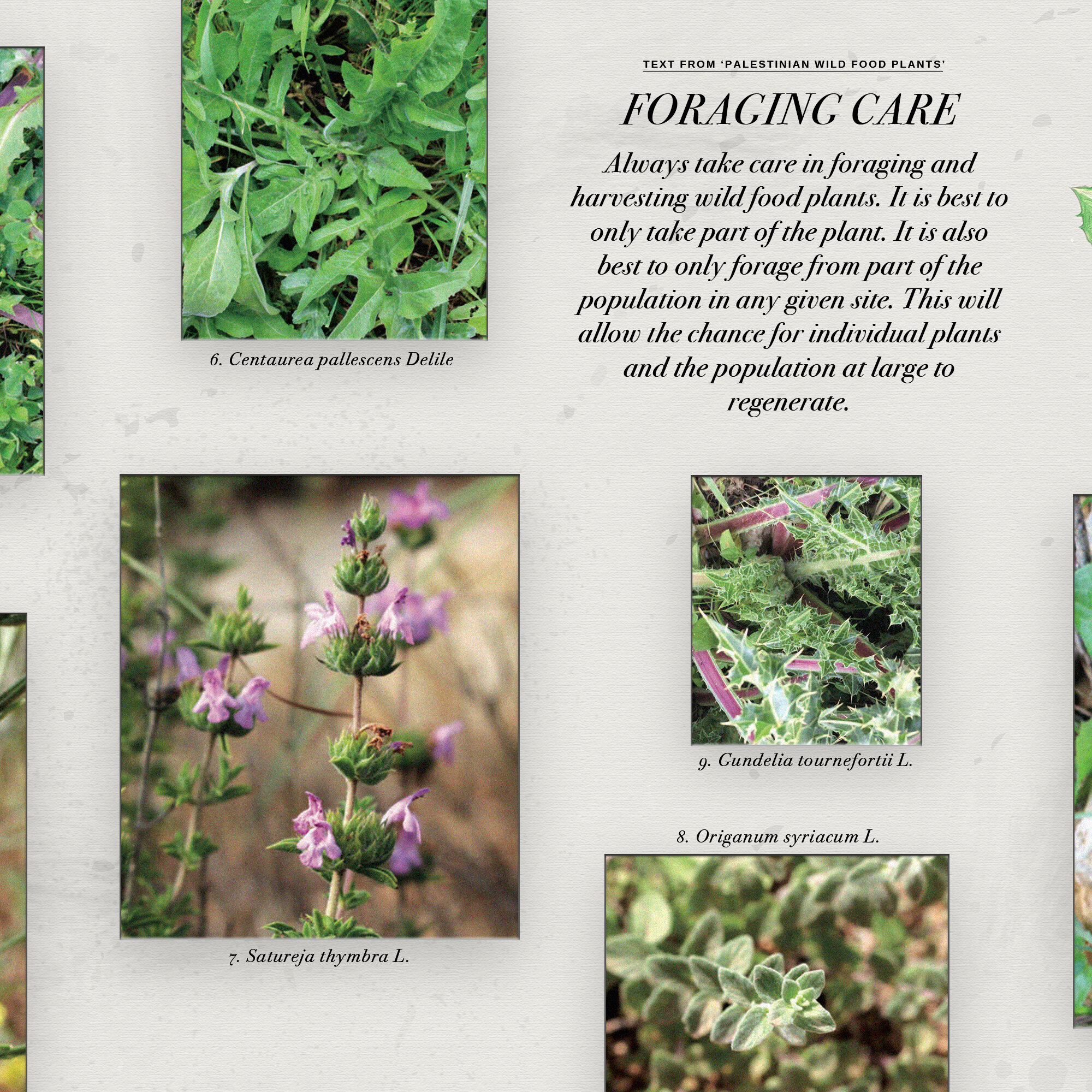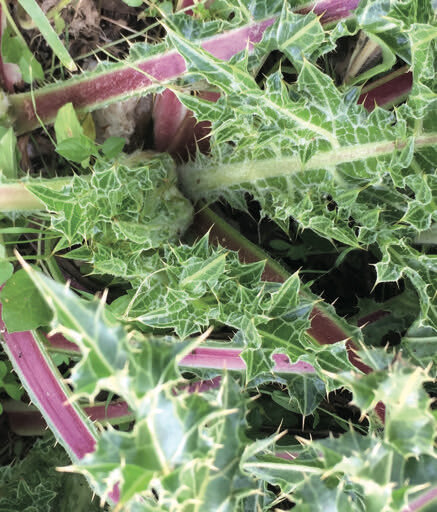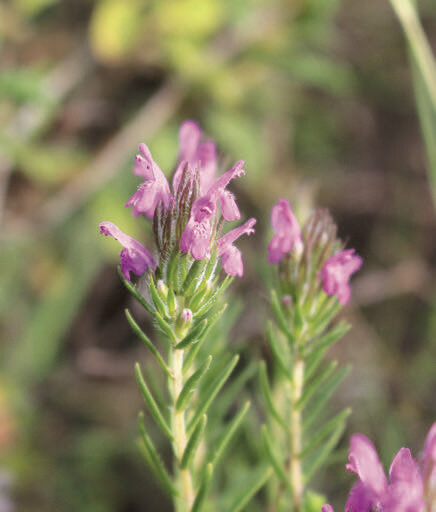‘Palestinian Wild Food Plants’ is a book that documents and illustrates the range of wild edible plants of Palestine that can be foraged (collected). Wild food plants refer to what grows without help from humans, including both annuals and perennials. In recent history, the agricultural reliance on high-yielding varieties has led to a catastrophic decline in crop diversity. Rather than functioning as a comprehensive document, the content of this book focuses on the hilly regions of the West Bank and provides practical information about common wild food plants ‘in the face of coming environmental challenges.’ Information for this book was collected through field transects in Salfit and Wadi al-Dib, analyzing print and online data sets, and open community discussions. Here we highlight some of the wild edible plants that can be foraged in May, as well as an essay by ‘Palestinian Wild Food Plants’ editor Omar Ismeeh Tesdell. Omar is a professor teaching geography and environmental studies at Birzeit University in Palestine. You can access the full digital book here.
*Photos by Yara Dowani & illustrations by Elizabeth Tesdell.
Wild Food Plants, Anthropocene, Palestine
By Omar Imseeh Tesdell
Wild food plants or wild edible plants have always been an important part of the human diet. They have provided the backbone of human survival for millennia before agricultural cultivation. They have continued to be important even with the advent of agricultural cultivation, when people began to train wild plants to produce food on a human schedule rather than a schedule bound to the microclimates of their locale.
Wild food plants grow without help from humans. Some are annuals, emerging in spring and summer to produce edible leaves, stems, owers, and then going to seed in order to grow again the next season. Some are perennials, and give useful leaves and fruits without the need to reemerge each year. They are foraged (collected) and either eaten raw or sautéed. Essentially every group of people around the world have relied, whether for sheer survival or culinary pleasure, on wild plants for food.
Moreover, foraging of wild food plants for most of these peoples is a deeply gendered enterprise with women functioning as the primary reservoir of knowledge and practice.
Wild food plants began to decline in importance as people trained grasses, legumes, and other wild plants to produce bigger seeds, ripen at the same time, and produce easily harvestable and storable grains. This process is ongoing and has taken thousands of years to transform a wild grass to produce the wheat plant as a viable agricultural grain. However, as recent work in paleoethnobotany has shown, reliance on wild plants ebbed and owed–it did not switch immediately–as part of the strategy for human survival in the case of periods of poor agricultural yields.
In the very recent history of the last two hundred years, the modern agricultural reliance on high-yielding crop varieties has resulted in a massive decline in the diversity in our crops as we depend now on only a few crops. For example, instead of every village in the Levant having its own heirloom varieties of wheat (as in Palestine with dibbiyyeh and heittiyyeh wheats), now we rely on a few varieties among many other wheats. Studies show that we have lost the vast majority, up to seventy-five percent, of these local varieties.
In Palestine, we have a particular relation to this question. It is in the general area of the Levant and Fertile Crescent that people transformed wild plants into some of the world’s most important grain crops, like Einkorn and Emmer wheats, barley, chickpea, flax, lentil, pea and bitter vetch. Here in the hills and open areas you can nd the wild relatives of these crops growing today without human interference. For more than 100 years, they have been explored, collected, and classified by scientists seeking to improve the domesticated crops with traits from their wild relatives.
There has been considerable work on the modern documentation of wild food plants and foraging in Palestine and the Levant. Much of this work emerged in the tradition of European and American ethnographers and scientists of the early twentieth century including George E. Post, Gustav Dalman, Grace Crowfoot, Louise Baldensperger, and Hilma Grandqvist. Palestinians, some of whom retained a professional relationship with international researchers, including Tawfik Canaan, Hanna Stephan Hanna, Omar Saleh al-Barghouthi, and others, contributed many works on the agriculture and peasant life of Palestine in this early period. Researchers coming from the Zionist movement also produced a massive amount of work on this topic to help drive the colonization project with special reference to Aaron Aaronsohn, Michael Zohary, Naomi Feinbrun, and Avinoam Danin. In response, a new generation of Palestinian researchers Shukri Arraf and Sharif Kanaaneh, among others, worked from the 1970’s through the 1990’s to document both plant and peasant life in Palestine. In addition, Mohammed Ali-Shtayeh and Rana Jamous have also extensively published on wild edible foods in Palestine.
In contrast to the above work, we do not aim to give an encyclopedic or comprehensive list of wild food plants. Moreover, we do not seek to make claims about the health or nutritional benefits of these plants.
Rather we offer a select list of common wild food plants in the hill region of the West Bank that are particularly useful and helpful in the face of coming environmental challenges. Building upon the Palestinian folkloric and scientific traditions noted above we provide a select list of wild edible food plants that may offer new avenues of exploration of alternative food crops in Palestine.
In early 2018 we used four interconnected research methods to produce the information you see here. First, we conducted two field transects with Amna Othman in Dayr Ballut (elevation 250m) a local wild plant expert in the Salfit district, cataloguing and photographing the plants. Second, we conducted two field transects to identify and photograph plants in Wadi al-Dilb near Ramallah (elevation 600m). Third, we cross-checked our taxonomic nomenclature with reliable print and online datasets to tie local names to the accepted scientific names. Fourth, we conducted an open community discussion at the Khalil al- Sakakini Cultural Center in Ramallah in April 2018 with more than fifty interested participants to document local plant names. This work was largely conducted by a core team of Omar Imseeh Tesdell, Yara Dowani, Yusra Othman, Saher Khoury, Renad Shqeirat, Yara Bamieh and Elizabeth Tesdell. We are especially grateful to Morgan Cooper and Saleh Totah of Mashjar Juthour, Ramallah, for their friendship and assistance in plant identification.
Plant classification and nomenclature is a delicate art. With regard to local Arabic names we decided to put as many names as possible, even in the case of overlap between plants, in order to document the diversity of local names. In the case of scientific names, we adhered strictly to the ‘accepted’ binomial nomenclature of the Global Biodiversity Information Facility (GBIF) http://www.gbif.org, which draws its datasets from other major world collections.
The centrality of Palestine
We are not alone in our renewed interest in foraging of wild food plants. In many parts of the world, but especially Europe and North America, researchers and small groups of people have been quietly working to rediscover and make available information about wild food plants.
Information on wild food plants is particularly important in the age of the proposed Anthropocene, or the first geologic epoch where humans have become a geologic force. Our total dependence in modern life on fossil fuels has led us to find ourselves asking probing questions about modern human modes of life. Problems of the Anthropocene such as carbon emissions, consumerism, lack of green space, and climate change are easily crowded out in Palestine by overriding concerns related to the Israeli occupation.
However, I would like to suggest that traditions of wild food plant foraging and the history of plant domestication in Palestine compel us to consider the Anthropocene from within the context of Palestine. If Palestine is implicated in the rise of agriculture, and agriculture is implicated in the coming of the carbon age, then Palestinians must participate in the discussion of the Anthropocene from within our context.
It is worth considering whether the Anthropocene formation may or may not be useful for us Palestinians. I recently led a workshop session to discuss the subject with high school science teachers and students at a science festival in Ramallah. We discussed the question of geologic time scale and the minuscule role of humans in shaping the history of the earth. At the same time, we discussed the surrounding rural areas where ancient peoples domesticated wild grasses and legumes, found in their landscape, to produce the first crops.
Most of the students and teachers came from villages to the west of Ramallah which now find themselves enmeshed in the Israeli frontier warren of separation barriers and checkpoints. They are also working with a local foundation to break away from the mostly retrograde Palestinian educational experience, which has more to do with producing docile students than free thinkers. However, the same wadis and hillsides have a pertinent history to the Anthropocene were one to look more deeply.
The Natuf valley, which winds from the highlands north of Jerusalem westward toward the Mediterranean Sea, is one of the first places early cultivators began to experiment in collecting, processing, and planting seeds from wild plants. The famed Natufian culture, a central player in the Neolithic plant experiments, stretched from modern-day Egypt to Turkey. It was named for the Natuf valley in Palestine by British archeologist Dorothy Garrod who excavated a major Natuan cave site, near the Palestinian village of Shuqba in the 1930s. Fascinatingly, this site is also the same area where the teachers and students participating in the Anthropocene discussion come from.
I briefly sketched the outlines of the sharp debate in the “advanced countries” (duwwal mutaqaddamah as our students here call them) on the subject of anthropogenic forces on the climate coming either from agricultural expansion or the dependence on fossil fuels. The Palestinian teachers and students come from village schools nestled amongst the hills that brought forth the so-called Neolithic revolution and are themselves a mere one or two generations now away from subsistence cultivation. Here in the Third World, a long way from idealized peasant worlds, it is difficult to deny that most people want to reap the comforts of modern life. The young people had a few things to say about the Anthropocene. In one particularly insightful moment, a young man and high school student, asked, “what use is the Anthropocene for us?”
I had a difficult time answering such a bold question, so I did what most college faculty do when they find themselves in such a situation, they pitch it back to the class so they can consider an answer. I looked around the room at the students and teachers and marveled at our collective transition from subsistence agriculture to a room showing all the signs of kitschy décor all too common in Palestine. Given a chance to gather my thoughts for a preliminary response, I understood the contours of the discussion better.
We Palestinians are a formerly agrarian society living amidst, some might say, the ruins of the agricultural revolution in its own origin place. So I said, “We were always part of the Anthropocene, so shouldn’t we also help to write its story now?” The young man nodded with the familiar zeal of a Palestinian student when challenged to be just as good as the rest of the world. He said, “Maybe it is a useful idea after all.”

















